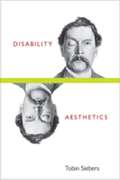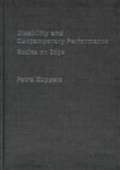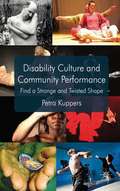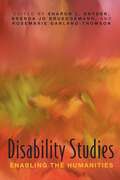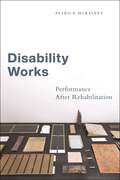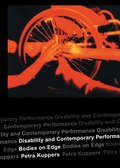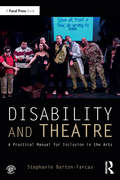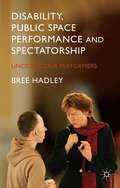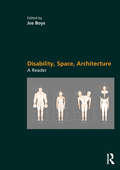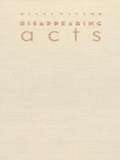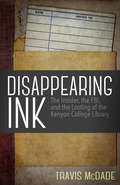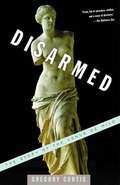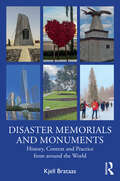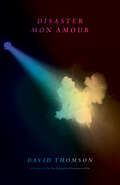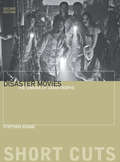- Table View
- List View
Dis-Orienting Planets: Racial Representations of Asia in Science Fiction
by Isiah Lavender IIIContributions by Suparno Banerjee, Cait Coker, Jeshua Enriquez, Joan Gordon, Veronica Hollinger, Malisa Kurtz, Stephanie Li, Bradford Lyau, Uppinder Mehan, Graham J. Murphy, Baryon Tensor Posadas, Amy J. Ransom, Robin Anne Reid, Haerin Shin, Stephen Hong Sohn, Takayuki Tatsumi, and Timothy J. Yamamura Isiah Lavender III's Dis-Orienting Planets amplifies critical issues surrounding the racial and ethnic dimensions of science fiction. This edited volume explores depictions of Asia and Asians in science fiction literature, film, and fandom with particular regard to China, Japan, India, and Korea. Dis-Orienting Planets highlights so-called yellow and brown peoples from the constellation of a historically white genre. The collection launches into political representations of Asian identity in science fiction's imagination, from fear of the Yellow Peril and its racist stereotypes to techno-Orientalism and the remains of a postcolonial heritage. Thus the essays, by contributors such as Takayuki Tatsumi, Veronica Hollinger, Uppinder Mehan, and Stephen Hong Sohn, reconfigure the very study of race in science fiction. A follow-up to Lavender's Black and Brown Planets, this collection expands the racial politics governing the renewed visibility of Asia in science fiction. One of the few on this subject, the volume probes Gary Shteyngart's novel Super Sad True Love Story, the acclaimed film Cloud Atlas, and Guillermo del Toro's monster film Pacific Rim, among others. Dis-Orienting Planets embarks on a wide-ranging assessment of Asian representations in science fiction, upon the determination that our visions of the future must include all people of color.
Disability Aesthetics
by Tobin SiebersDisability Aesthetics ambitiously redefines both 'disability' and 'aesthetics,' showing us that disability is central not only to modern art but also to the way we apprehend (and interact with) bodies and buildings. Along the way, Tobin Siebers revisits the beautiful and the sublime, 'degenerate' art and 'disqualified' bodies, culture wars and condemned neighborhoods, the art of Marc Quinn and the fiction of Junot Díaz---and much, much more. Disability Aesthetics is a stunning achievement, a must-read for anyone interested in how to understand the world we half create and half perceive." ---Michael Bérubé, Paterno Family Professor in Literature, Pennsylvania State University. "Rich with examples of the disabled body in both historical and modern art, Tobin Siebers's new book explores how disability problematizes commonly accepted ideas about aesthetics and beauty. For Siebers, disability is not a pejorative condition as much as it is a form of embodied difference. He is as comfortable discussing the Venus de Milo as he is discussing Andy Warhol. Disability Aesthetics is a prescient and much-needed contribution to visual & critical studies." ---Joseph Grigely, Professor of Visual and Critical Studies, The School of the Art Institute of Chicago. Disability Aesthetics is the first attempt to theorize the representation of disability in modern art and visual culture. It claims that the modern in art is perceived as disability, and that disability is evolving into an aesthetic value in itself. It argues that the essential arguments at the heart of the American culture wars in the late twentieth century involved the rejection of disability both by targeting certain artworks as "sick" and by characterizing these artworks as representative of a sick culture. The book also tracks the seminal role of National Socialism in perceiving the powerful connection between modern art and disability. It probes a variety of central aesthetic questions, producing a new understanding of art vandalism, an argument about the centrality of wounded bodies to global communication, and a systematic reading of the use put to aesthetics to justify the oppression of disabled people. In this richly illustrated and accessibly written book, Tobin Siebers masterfully demonstrates the crucial roles that the disabled mind and disabled body have played in the evolution of modern aesthetics, unveiling disability as a unique resource discovered by modern art and then embraced by it as a defining concept. Tobin Siebers is V. L. Parrington Collegiate Professor of English Language and Literature and Art and Design at the University of Michigan. His many books include Disability Theory and The Subject and Other Subjects: On Ethical, Aesthetic, and Political Identity. A volume in the series Corporealities: Discourses of Disability.
Disability And Contemporary Performance: Bodies On The Edge
by Petra KuppersDisability and Contemporary Performance presents a remarkable challenge to existing assumptions about disability and artistic practice. In particular, it explores where cultural knowledge about disability leaves off, and the lived experience of difference begins. Petra Kuppers, herself an award-winning artist and theorist, investigates the ways in which disabled performers challenge, change and work with current stereotypes through their work. She explores freak show fantasies and 'medical theatre' as well as live art, webwork, theatre, dance, photography and installations, to cast an entirely new light on contemporary identity politics and aesthetics. <p><p> This is an outstanding exploration of some of the most pressing issues in performance, cultural and disability studies today, written by a leading practitioner and critic.
Disability Culture and Community Performance
by Petra KuppersPerformances in hospices andon beaches; cross-cultural myth making in Wales, New Zealand and the US; communal poetry among mental health system survivors: this book presents a senior practitioner/critic's exploration of arts-based research processes sustained over more than a decade -a subtle engagement with disability culture. "
Disability Identity in Simulation Narratives (Literary Disability Studies)
by Anelise HaukaasDisability Identity in Simulation Narratives considers the relationship between disability identity and simulation activities (ranging from traditional gameplay to more revolutionary technology) in contemporary science fiction. Anelise Haukaas applies posthumanist theory to an examination of disability identity in a variety of science fiction texts: adult novels, young adult literature and comics, as well as ethnographic research with gamers. Haukaas argues that instead of being a means of escapism, simulated experiences are a valuable tool for cultivating self-acceptance and promoting empathy. Through increasingly accessible technology and innovative gameplay, traditional hierarchies are dismantled, and different ways of being are both explored and validated. Ultimately, the book aims to expand our understandings of disability, performance, and self-creation in significant ways by exploring the boundless selves that the simulated environments in these texts allow.
Disability Representation in Film, TV, and Print Media (Interdisciplinary Disability Studies)
by Michael S. JeffressUsing sources from a wide variety of print and digital media, this book discusses the need for ample and healthy portrayals of disability and neurodiversity in the media, as the primary way that most people learn about conditions. It contains 13 newly written chapters drawing on representations of disability in popular culture from film, television, and print media in both the Global North and the Global South, including the United States, Canada, India, and Kenya. Although disability is often framed using a limited range of stereotypical tropes such as victims, supercrips, or suffering patients, this book shows how disability and neurodiversity are making their way into more mainstream media productions and publications with movies, television shows, and books featuring prominent and even lead characters with disabilities or neurodiversity. Disability Representation in Film, TV, and Print Media will be of interest to all scholars and students of disability studies, cultural studies, film studies, gender studies, and sociology more broadly.
Disability Studies: Enabling the Humanities
by Brenda Jo Brueggemann Sharon L. Snyder Rosemarie Garland-ThomsonImages of disability pervade language and literature, yet disability is, as the volume's introduction notes, "the ubiquitous unspoken topic in contemporary culture." The twenty-five essays in Disability Studies provide perspectives on disabled people and on disability in the humanities, art, the media, medicine, psychology, the academy, and society.Edited and introduced by Sharon L. Snyder, Brenda Jo Brueggemann, and Rosemarie Garland-Thomson and containing an afterword by Michael Bérubé (author of Life As We Know It), the volume is rich in its cast of characters (including John Bulwer, Teresa de Cartagena, Audre Lorde, Oliver Sacks, Samuel Johnson, Mark Twain, Walt Whitman); in its powerful, authentic accounts of disabled conditions (deafness, blindness, MS, cancer, the absence of limbs); in its different settings (ancient Greece, medieval Spain, Nazi Germany, the modern United States); and in its mix of the intellectual and the emotional, of subtle theory and plainspoken autobiography.
Disability Works: Performance After Rehabilitation (Performance and American Cultures #8)
by Patrick McKelveyA cultural history of disability, performance, and work in the modern United StatesIn 1967, the US government funded the National Theatre of the Deaf, a groundbreaking rehabilitation initiative employing deaf actors. This project aligned with the postwar belief that transforming bodies, minds, aesthetics, and institutions could liberate disabled Americans from economic reliance on the state, and demonstrated the growing optimism that performance could provide job opportunities for people with disabilities.Disability Works offers an original cultural history of disability and performance in modern America, exploring rehabilitation’s competing legacies. The book highlights an unexpected alliance of rehabilitation professionals, deaf teachers, policy makers, disability activists, queer artists, and religious leaders who championed performance’s rehabilitative potential. At the same time, some disabled artists imagined a different political itinerary for theatrical practice. Rather than acquiescing to the terms of productive citizenship, these artists recuperated rehabilitation as a creative resource for imagining and building a world beyond work. Using previously unexplored archives, Disability Works portrays the history of disabled Americans’ performance labor as both a national aspiration and a national problem. The book reveals how disabled artists and activists ingeniously used rehabilitative resources to fuel their performance practices, breaking free from the grasp of rehabilitation and fostering more just institutions.From state-funded “sign-mime” to Black modern dance, community theatre to Stanislavskian actor training, speculative activism to epistolary performance, Disability Works recovers an expansive repertoire of aesthetic and infrastructural investigations into the terms of how disability works in modern American culture.
Disability and Art History from Antiquity to the Twenty-First Century (Interdisciplinary Disability Studies)
by Ann Millett-GallantThis volume analyzes representations of disability in art from antiquity to the twenty-first century, incorporating disability studies scholarship and art historical research and methodology. This book brings these two strands together to provide a comprehensive overview of the intersections between these two disciplines. Divided into four parts: Ancient History through the 17th Century: Gods, Dwarfs, and Warriors 17th-Century Spain to the American Civil War: Misfits, Wounded Bodies, and Medical Specimens Modernism, Metaphor and Corporeality Contemporary Art: Crips, Care, and Portraiture and comprised of 16 chapters focusing on Greek sculpture, ancient Chinese art, Early Italian Renaissance art, the Spanish Golden Age, nineteenth century art in France (Manet, Toulouse-Lautrec) and the US, and contemporary works, it contextualizes understandings of disability historically, as well as in terms of medicine, literature, and visual culture. This book is required reading for scholars and students of disability studies, art history, sociology, medical humanities and media arts.
Disability and Contemporary Performance: Bodies on the Edge
by Petra KuppersDisability and Contemporary Performance presents a remarkable challenge to existing assumptions about disability and artistic practice. In particular, it explores where cultural knowledge about disability leaves off, and the lived experience of difference begins. Petra Kuppers, herself an award-winning artist and theorist, investigates the ways in which disabled performers challenge, change and work with current stereotypes through their work. She explores freak show fantasies and 'medical theatre' as well as live art, webwork, theatre, dance, photography and installations, to cast an entirely new light on contemporary identity politics and aesthetics. This is an outstanding exploration of some of the most pressing issues in performance, cultural and disability studies today, written by a leading practitioner and critic.
Disability and Digital Television Cultures: Representation, Access, and Reception (Routledge Research in Disability and Media Studies)
by Katie EllisDisability and Digital Television Cultures offers an important addition to scholarly studies at the intersection of disability and media, examining disability in the context of digital television access, representation and reception. Television, as a central medium of communication, has marginalized people with disability through both representation on screen and the lack of accessibility to this medium. With accessibility options becoming available as television is switched to digital transmissions, audience research into television representations must include a corresponding consideration of access. This book provides a comprehensive and critical study of the way people with disability access and watch digital TV. International case studies and media reports are complimented by findings of a user-focused study into accessibility and representation captured during the Australian digital television switchover in 2013-2014. This book will provide a reliable, independent guide to fundamental shifts in media access while also offering insight from the disability community. It will be essential reading for researchers working on disability and media, as well as television, communications and culture; upper-level undergraduate and postgraduate students in cultural studies; along with general readers with an interest in disability and digital culture.
Disability and Theatre: A Practical Manual for Inclusion in the Arts
by Stephanie Barton FarcasDisability and Theatre: A Practical Manual for Inclusion in the Arts is a step-by step manual on how to create inclusive theatre, including how and where to find actors, how to publicize productions, run rehearsals, act intricate scenes like fights and battles, work with unions, contracts, and agents, and deal with technical issues. This practical information was born from the author’s 16 years of running the first inclusive theatre company in New York City, and is applicable to any performance level: children’s theatre, community theatre, regional theatre, touring companies, Broadway, and academic theatre. This book features anecdotal case studies that emphasize problem solving, real-world application, and realistic action plans. A comprehensive Companion Website provides additional guidelines and hands-on worksheets.
Disability in Comic Books and Graphic Narratives (Literary Disability Studies)
by Zach WhalenAs there has yet to be any substantial scrutiny of the complex confluences a more sustained dialogue between disability studies and comics studies might suggest, Disability in Comic Books and Graphic Narratives aims through its broad range of approaches and focus points to explore this exciting subject in productive and provocative ways.
Disability, Media, and Representations: Other Bodies (Routledge Research in Disability and Media Studies)
by Jacob Johanssen Diana GarrisiBringing together scholars from around the world to research the intersection between media and disability, this edited collection aims to offer an interdisciplinary exploration and critique of print, broadcast and online representations of physical and mental impairments.Drawing on a wide range of case studies addressing how people can be ‘othered’ in contemporary media, the chapters focus on analyses of hateful discourses about disability on Reddit, news coverage of disability and education, media access of individuals with disabilities, the logic of memes and brain tumour on Twitter, celebrity and Down Syndrome on Instagram, disability in TV drama, the metaphor of disability for the nation; as well as an autoethnography of treatment of breast cancer. Providing a much-needed global perspective, Disability, Media, and Representations examines the relationship between self-representation and representations in either reinforcing or debunking myths around disability, and ways in which academic discourse can be differently articulated to study the relationship between media and disability. This book will be of interest to students and researchers of disability studies and media studies as well as activists and readers engaged in debates on diversity, inclusivity and the media.
Disability, Public Space Performance and Spectatorship
by Bree HadleyIn Disability, Public Space Performance and Spectatorship: Unconscious Performers, Bree Hadley examines the performance practices of disabled artists in the US, UK, Europe and Australasia who re-engage, re-enact and re-envisage the stereotyping they are subject to in the very public spaces and places where this stereotyping typically plays out.
Disability, Space, Architecture: A Reader
by Jos BoysDisability, Space, Architecture: A Reader takes a groundbreaking approach to exploring the interconnections between disability, architecture and cities. The contributions come from architecture, geography, anthropology, health studies, English language and literature, rhetoric and composition, art history, disability studies and disability arts and cover personal, theoretical and innovative ideas and work. Richer approaches to disability – beyond regulation and design guidance – remain fragmented and difficult to find for architectural and built environment students, educators and professionals. By bringing together in one place some seminal texts and projects, as well as newly commissioned writings, readers can engage with disability in unexpected and exciting ways that can vibrantly inform their understandings of architecture and urban design. Most crucially, Disability, Space, Architecture: A Reader opens up not just disability but also ability – dis/ability – as a means of refusing the normalisation of only particular kinds of bodies in the design of built space. It reveals how our everyday social attitudes and practices about people, objects and spaces can be better understood through the lens of disability, and it suggests how thinking differently about dis/ability can enable innovative and new kinds of critical and creative architectural and urban design education and practice.
Disabled People Transforming Media Culture for a More Inclusive World (Routledge Research in Disability and Media Studies)
by Beth A. HallerThis book tells the stories of disabled people who have been influential in creating modern mass media. Through the voices of key disabled media makers and collaborators, the author highlights the ways in which their contributions are changing society’s understanding of disability and shaping mass media and culture. Spanning a range of media formats – television/streaming productions, performances, podcasts, TED Talks, films, reality TV, graphic novels, and social media channels – the book illustrates how disabled people are confronting the marginalization they have faced in mass media for decades. Modern disabled media creators are leveraging new media platforms to recognize the lived experiences of disability and their authentic place in media culture. This innovative and thought-provoking volume will be an important read for scholars, disability advocates, and students of Disability Studies, Mass Communication/Media Studies, as well as mass media production faculty, disabled people, and their allies The Open Access version of this book, available at http://www.taylorfrancis.com, has been made available under a Creative Commons Attribution-Non Commercial-No Derivatives (CC-BY-NC-ND) 4.0 license.
Disappearing Acts: Spectacles of Gender and Nationalism in Argentina’s “Dirty War”
by Diana TaylorIn Disappearing Acts, Diana Taylor looks at how national identity is shaped, gendered, and contested through spectacle and spectatorship. The specific identity in question is that of Argentina, and Taylor's focus is directed toward the years 1976 to 1983 in which the Argentine armed forces were pitted against the Argentine people in that nation's "Dirty War." Combining feminism, cultural studies, and performance theory, Taylor analyzes the political spectacles that comprised the war--concentration camps, torture, "disappearances"--as well as the rise of theatrical productions, demonstrations, and other performative practices that attempted to resist and subvert the Argentine military.Taylor uses performance theory to explore how public spectacle both builds and dismantles a sense of national and gender identity. Here, nation is understood as a product of communal "imaginings" that are rehearsed, written, and staged--and spectacle is the desiring machine at work in those imaginings. Taylor argues that the founding scenario of Argentineness stages the struggle for national identity as a battle between men--fought on, over, and through the feminine body of the Motherland. She shows how the military's representations of itself as the model of national authenticity established the parameters of the conflict in the 70s and 80s, feminized the enemy, and positioned the public--limiting its ability to respond. Those who challenged the dictatorship, from the Mothers of the Plaza de Mayo to progressive theater practitioners, found themselves in what Taylor describes as "bad scripts." Describing the images, myths, performances, and explanatory narratives that have informed Argentina's national drama, Disappearing Acts offers a telling analysis of the aesthetics of violence and the disappearance of civil society during Argentina's spectacle of terror.
Disappearing Ink: The Insider, the FBI, and the Looting of the Kenyon College Library
by Travis McDadeThe remarkable true story of the document heist that shocked the world. Like many aspiring writers, David Breithaupt had money problems. But what he also had was unsupervised access to one of the finest special collections libraries in the country. In October 1990, Kenyon College hired Breithaupt as its library’s part-time evening supervisor. In April 2000, he was fired after a Georgia librarian discovered him selling a letter by Flannery O’Connor on eBay, but that was only the tip of the iceberg: for the past ten years, Breithaupt had been browsing the collection, taking from it whatever rare books, manuscripts, and documents caught his eye—W. H. Auden annotated typescripts, a Thomas Pynchon manuscript, and much, much more. It was a large-scale, long-term pillaging of Kenyon College’s most precious works. After he was caught, the American justice system looked like it was about to disappoint the college the way it had countless rare book crime victims before—but Kenyon, refused to let this happen . . .
Disarmed: The Story of the Venus de Milo
by Greg CurtisIn the spring of 1820, on the Aegean island of Melos, an unsuspecting farmer was digging for marble building blocks when he unearthed the statue that would come to be known as the Venus de Milo. From the moment of its discovery a battle for possession ensued and was won, eventually, by the French. Touted by her keepers in the Louvre as the great classical find of the era, the sculpture gained instant celebrity–and yet its origins had yet to be documented or verified. From the flurry of excitement surrounding her discovery, to the raging disputes over her authenticity, to the politics and personalities that have given rise to her mystique, Gregory Curtis has given us a riveting look at the embattled legacy of a beloved icon and a remarkable tribute to one of the world’s great works of art.
Disaster Cinema in Historical Perspective: Mediations of the Sublime (Film Culture in Transition)
by Nikita MathiasHow do we experience disaster films in cinema? And where does disaster cinema come from? The two questions are more closely related than one might initially think. For the framework of the cinematic experience of natural disasters has its roots in the mid-eighteenth century when the aesthetic category of the sublime was re-established as the primary mode for appreciating nature's violent forces. In this book, the sublime is understood as a complex and culturally specific meeting point between philosophical thought, artistic creation, social and technical development, and popular imagination. On the one hand, the sublime provides a receptive model to uncover how cinematic disaster depictions affect our senses, bodies and minds. On the other hand, this experiential framework of disaster cinema is only one of the most recent agents within the historical trajectory of sublime disasters, which is traced in this book among a broad range of media: from landscape and history painting to a variety of pictorial devices like Eidophusikon, Panorama, Diorama, and, finally, cinema.
Disaster Memorials and Monuments: History, Context and Practice from around the World
by Kjell BrataasBringing together the historical and the contemporary, the political and the personal, Disaster Memorials and Monuments: History, Context and Practice from around the World presents a wide-ranging understanding and exploration on memorials and monuments built in the aftermath of accidents, natural disasters and acts of violence.Disaster management expert, Kjell Brataas, provides a compassionate voice to difficult and complex situations as well as practical advice based on lessons learned through academic research, site visits and personal experience. Brataas illustrates a wide range of monuments and memorial projects from all over the world and explains the process of their creation and the challenges that occur in memorialization processes. He further proposes strategies for dealing with trials and controversies in similar future developments.Features include: Personal interviews with key stakeholders in the field of memorializing, psychology and victim support, who have first-hand experience with memorial projects Insights, lessons learned and advice from scholars, professors, politicians, support group leaders, survivors, bereaved, community leaders and neighbors Reporting on more than 80 memorials from around the world, including New Zealand, Canada, the United States, Sahara, Chile, Japan and South Korea Suggested reading, including books, reports and presentations on the topic Disaster Memorials and Monuments: History, Context and Practice from around the World is important reading for all practicing professionals, for those who study and teach the importance and the process of developing memorials and monuments and for everyone interested in crisis management and the aftermath of disasters.
Disaster Mon Amour
by David ThomsonA deep—and darkly comic—dive into the nature of disasters, and the ways they shape how we think about ourselves in the world &“In this brilliant book, David Thomson tells the story of how we came to make disaster and catastrophe our best friends—how we let terror cocoon and take over our imaginations to avoid seeing the things that really frighten us. Riveting and totally original.&”—Adam Curtis, BBC filmmaker and political journalist &“Erudite. . . . Engaging. . . . A cri de coeur about art&’s struggle to keep up with reality.&”—Kirkus Reviews Audiences swell with the scale of disaster; humans have always been drawn to the rumors of our own demise. In this searching treatment, noted film historian David Thomson examines iconic disasters, both real and fictional, exposing the slippage between what occurs and what we observe. With reportage, film commentary, speculation, and a liberating sense of humor, Thomson shows how digital culture commodifies disaster and sates our desire to witness chaos while suffering none of its aftereffects. Ranging from Laurel and Hardy and Battleship Potemkin to Cormac McCarthy&’s The Road, and from the epic San Andreas to the intimate Don&’t Look Now, Thomson pulls back the curtain to reveal why we love watching disaster unfold—but only if it happens to others.
Disaster Movies
by Stephen KeaneStephen Keane's history of the disaster genre offers a detailed analysis of films such as The Towering Inferno, Independence Day, Titanic, and The Day After Tomorrow. He looks at the ways in which disaster movies can be read in relation to both contextual considerations and the increasing commercial demands of contemporary Hollywood. In this second edition, he adds new material regarding cinematic representations of disaster in the wake of 9/11 and an analysis of disaster movies in light of recent natural disasters. Keane continually reworks this previously unexplored genre.
Disaster Movies: The Cinema of Catastrophe (Short Cuts)
by Stephen KeaneStephen Keane's history of the disaster genre offers a detailed analysis of films such as The Towering Inferno, Independence Day, Titanic, and The Day After Tomorrow. He looks at the ways in which disaster movies can be read in relation to both contextual considerations and the increasing commercial demands of contemporary Hollywood. In this second edition, he adds new material regarding cinematic representations of disaster in the wake of 9/11 and an analysis of disaster movies in light of recent natural disasters. Keane continually reworks this previously unexplored genre.

